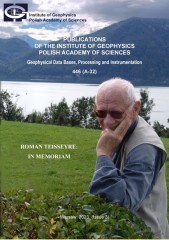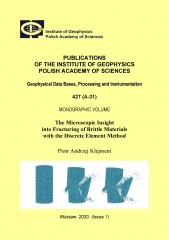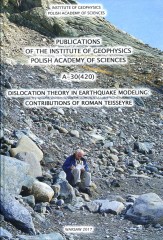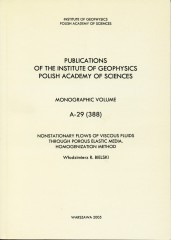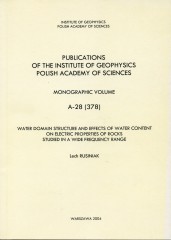BROWSE - VOLUME LIST
- A - Physics of the Earth's Interior
- B - Seismology
-
C - Geomagnetism
C-119, C-118, C-117, C-116, C-115, C-114, C-113, C-112, C-111, C-110, C-109, C-108, C-107, C-106, C-105, C-104, C-103, C-102, C-101, C-100, C-99, C-98, C-97, C-96, C-95, C-94, C-93, C-92, C-91, C-90, C-89, C-88, C-87, C-86, C-85, C-84, C-83, C-82, C-81, C-80, C-79, C-78, C-77, C-76, C-75, C-74, C-73, C-72, C-71, C-70, C-69, C-68, C-67, C-66, C-65, C-64, C-63, C-62, C-61, C-60, C-59, C-58, C-57, C-56, C-55, C-54, C-53, C-52, C-51, C-50, C-49, C-48, C-47, C-46, C-45, C-44, C-43, C-42, C-41, C-40, C-39, C-38, C-37, C-36, C-35, C-33, C-32, C-31, C-30, C-29, C-28, C-27, C-26, C-25, C-24, C-23, C-22, C-21, C-20, C-19, C-18, C-17, C-16, C-15, C-14, C-13, C-12, C-11, C-10, C-9, C-8, C-7, C-6, C-5, C-4, C-3, C-2, C-1
-
D - Physics of the Atmosphere
D-79, D-78, D-77, D-76, D-75, D-74, D-73, D-72, D-71, D-70, D-69, D-68, D-67, D-66, D-65, D-64, D-63, D-62, D-61, D-60, D-59, D-58, D-57, D-56, D-55, D-54, D-53, D-52, D-51, D-50, D-49, D-48, D-47, D-46, D-44, D-45, D-43, D-42, D-41, D-40, D-39, D-38, D-37, D-35, D-34, D-33, D-32, D-31, D-30, D-28, D-27, D-26, D-25, D-24, D-23, D-22, D-21, D-20, D-19, D-18, D-17, D-16, D-15, D-14, D-13, D-12, D-11, D-10, D-9, D-8, D-7, D-6, D-5, D-4, D-3, D-2, D-1
- E - Hydrology
- P - Polar Research
- M - Miscellanea
-
Online First
A - Physics of the Earth's Interior
Roman Teisseyre: In Memoriam
Author(s):
Volume: 446
Series: A-32
DOI: 10.25171/InstGeoph_PAS_Publs-2023-003
Volume: 446
Series: A-32
DOI: 10.25171/InstGeoph_PAS_Publs-2023-003
Professor Roman Teisseyre, the outstanding modern geophysicist, was one of the most important and influential persons in the whole history of the Institute of Geophysics, Polish Academy of Sciences. His death ended the era of the founders and managers of the Institute who shaped, from its very beginning, the basic scientific profile of our place. Also, the friendly and pleasant atmosphere among the people working there, as initiated by him and the whole group of Institute’s founders, was prevalent over the years. He had many, many friends who quickly responded to our appeal to contribute to the present book In Memoriam.
The Microscopic Insight into Fracturing of Brittle Materials with the Discrete Element Method
Author(s): Klejment P.
Volume: 427
Series: A-31
DOI: 10.25171/InstGeoph_PAS_Publs-2020-001
Volume: 427
Series: A-31
DOI: 10.25171/InstGeoph_PAS_Publs-2020-001
In this work, the analysis of the issue of material fracturing in geophysical applications was undertaken. The Discrete Element Method was used, which is ideally suited for simulating the fracturing process, because it assumes a discrete model of matter (consisting of particles), and also allows to considerate all kinds of issues related to particle rotations and movements.
Dislocation Theory in Earthquake Modeling: Contributions of Roman Teisseyre
Editor(s): Dziembowska A., Czechowski Z.
Volume: 420
Series: A-30
Volume: 420
Series: A-30
Roman Teisseyre was one of the pioneers of applying the dislocation theory in geophysics. The present book recollects his major publications of the years 1961−1990, the milestones in the consecutive stages of the development of the Theory of Earthquake Premonitory and Fracture Processes. The collection reproduced here, showing the evolution of the Author’s ideas, is sort of backup and supplement to monographic publications and gives the reader an easy insight into some top positions representing numerous papers scattered over various journals and books.
Nonstationary Flows of Viscous Fluids through Porous Elastic Media. Homogenization Method
Author(s): Bielski W.
Volume: 388
Series: A-29
Volume: 388
Series: A-29
Porous media found in the natural environment represent a good example of media with microstructure. Their pores contain different phases of liquids and gases filling them as well as the interfaces between the phases. This issue has been frequently discussed by soil physicists and chemists, chemical and petro engineers, seismologists and other researchers interested in geosciences.
Water Domain Structure and Effects of Water Content on Electric Properties of Rocks Studied in a Wide Frequency Range
Author(s): Rusiniak L.
Volume: 378
Series: A-28
Volume: 378
Series: A-28
Water is one of the most common substances, widespread on the Earth in different states of matter. It has an essential influence on many climatic and atmospheric phenomena. In the Earth's crust, water influences mechanical and electrical behaviour of various structures. The electric properties of moist porous rocks are very important in many branches of geophysics. The moist porous rock material is very interesting from physical point of view, as it is a solid dielectric with a liquid dipole dielectric in the pores, cracks and other structural defects. There are good prospects of practical use of the results of measurements of electric properties of such rocks in non-destructive testing and in the study of water inside various products and materials.


